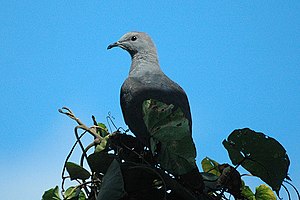Peales fruit pigeon
| Peales fruit pigeon | ||||||||||
|---|---|---|---|---|---|---|---|---|---|---|

Peales fruit pigeon |
||||||||||
| Systematics | ||||||||||
|
||||||||||
| Scientific name | ||||||||||
| Ducula latrans | ||||||||||
| ( Peale , 1848) |
The Peales fruit pigeon ( Ducula latrans ) is a large species of pigeon birds that is one of the fruit pigeons . It occurs exclusively on the Fijian archipelago, an archipelago in the South Pacific.
The population of the Peales fruit pigeon is given by the IUCN as Least Concern (not endangered).
Appearance
The Peales fruit pigeon reaches a body length of about 42 centimeters. It is about the size of a wood pigeon . The tail accounts for 14.9 to 15.7 centimeters. The beak is 1.9 to 2.2 centimeters long. There is no noticeable gender dimorphism . The females are only slightly dull in color.
The front of the head, the reins and the crown are dark ash gray. The plumage is reddish red on the center of the crown and in the neck. The throat is smoky gray, the defect is shiny brown. The elytra are similarly colored, the individual feathers have matt brown edges. The arm wings are matte brown with a slight shade of gray. The wings of the hand are blackish. The back and the upper tail covers have a warm shade of brown. The tail is also brown.
The chin and throat are pale wine-red to isabel-colored. The front neck is ash gray. The chest is darker than the neck and is also tinged with wine red. The belly is light mauve-pink. The under tail coverts are matt brown. The iris, orbital ring, and eyelids are red. The beak is black. The feet are red or maroon.
Fledglings are similar to adult birds. But they still lack the wine-red colors. Most feathers have red-brown to isabel-colored hems.
Possible confusion
The Tonga pigeon also occurs in the distribution area of the Peales fruit pigeon . This is smaller and has a noticeably enlarged black wax skin. The under tail coverts are dark chestnut brown in this species. The elytra are pale gray.
Distribution area
The Peales fruit pigeon only comes to the Fiji Islands and colonizes all the larger islands here. It is a little rarer where it overlaps with the tonga cockerel. It is heavily hunted in its area of distribution, but is still considered common.
The habitat are the lowland and mountain forests.
Way of life
In the dense jungle, the Peales fruit pigeon is mainly in the treetops, where it looks for its fruit-based food. Only very rarely does she get on the ground. Typical of this species is a noisy fluttering and scrambling in the tree tops. It often hangs upside down on the branches to get to the fruit. The flight is fast and direct with slow and steady wing beats.
Little is known about the breeding biology of this species. The nests, however, are typical of a pigeon, a loose platform made of small branches that is erected in a fork of a branch. The clutch consists of a single egg.
literature
- David Gibbs, Eustace Barnes and John Cox: Pigeons and Doves - A Guide to the Pigeons and Doves of the World . Pica Press, Sussex 2001, ISBN 90-74345-26-3 .
- Gerhard Rösler: The wild pigeons of the earth - free living, keeping and breeding . M. & H. Schaper Verlag, Alfeld-Hannover 1996, ISBN 3-7944-0184-0 .
Web links
- Ducula latrans in the endangered Red List species the IUCN 2012. Posted by: BirdLife International, 2012. Accessed December 3, 2016th